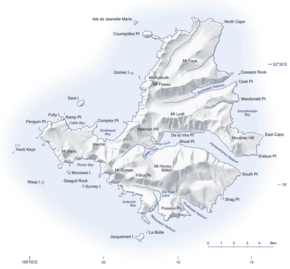Biology:Campbell Islands
 Map of the Campbell Islands | |
 Location relative to New Zealand and other outlying islands | |
| Geography | |
|---|---|
| Coordinates | [ ⚑ ] : 52°32′S 169°09′E / 52.533°S 169.15°E |
| Area | 113.31 km2 (43.75 sq mi) |
| Highest elevation | 558 m (1831 ft) |
| Highest point | Mount Honey |
| Administration | |
| Demographics | |
| Population | Uninhabited |
The Campbell Islands (or Campbell Island Group) are a group of subantarctic islands, belonging to New Zealand . They lie about 600 km south of Stewart Island. The islands have a total area of 113.31 km2 (43.75 sq mi),[1] consisting of one big island, Campbell Island (112.68 km2 or 43.51 sq mi), and several small islets, notably Dent Island (0.23 km2 or 0.089 sq mi), Isle de Jeanette Marie (0.11 km2 or 0.042 sq mi), Folly Island (or Folly Islands), Jacquemart Island (0.19 km2 or 0.073 sq mi), and Monowai Island (also known as Lion Rock, 0.08 km2 or 0.031 sq mi).[2] Ecologically, they are part of the Antipodes Subantarctic Islands tundra ecoregion. The islands are one of five subantarctic island groups collectively designated as a World Heritage Site by UNESCO.[3]
Geography
- Campbell Island ( [ ⚑ ] 52°32.4′S 169°8.7′E / 52.54°S 169.145°E)
- Dent Island ( [ ⚑ ] 52°31.15′S 169°3.75′E / 52.51917°S 169.0625°E)
- Jacquemart Island ( [ ⚑ ] 52°37′S 169°7.5′E / 52.617°S 169.125°E)
- Folly Island or Folly Islands
The islands are relatively flat; due to tectonic pressure, however, there are mountains in the centre of each island. A sea stack at the southern tip of Jacquemart Island is – with the exception of the country's Antarctic claims – New Zealand's southernmost point.
Flora and Fauna
Since its discovery in 1810, the flora and fauna have been under threat from mammals introduced by humans. Cats (Felis catus) and Norway rats (Rattus novegicus) prey on native birds and much of the vegetation was destroyed by sheep (Ovis aries) and cattle (Bos taurus). Restoration of the island began in 1970 with the removal of the feral cattle and sheep; subsequently the island's vegetation recovered, becoming denser. In 2001, four helicopters, under instruction from the New Zealand Department of Conservation (DOC) spread 120 tonnes of rodenticide-laced bait across the island over one month. Repeated monitoring has found no signs of rats since. This operation became a template for rat eradication on other islands around the world.[4]
Important Bird Area
The Campbell Islands have been identified as an Important Bird Area (IBA) by BirdLife International because of its significance as a breeding site for several species of seabirds as well as the endemic Campbell teal and Campbell snipe. The seabirds are southern rockhopper and yellow-eyed penguins, Antipodean, southern royal, light-mantled, black-browed, Campbell and grey-headed albatrosses, northern giant and white-chinned petrels, and the Campbell shag.[5]
See also
- Desert island
- List of Antarctic and subantarctic islands
- List of islands
- List of islands of New Zealand
- New Zealand Subantarctic Islands
References
- ↑ "Data Table - Protected Areas - LINZ Data Service (recorded area 11331 ha)". Land Information New Zealand. https://data.linz.govt.nz/layer/53564-protected-areas/data/93952/. Retrieved 12 February 2021.
- ↑ [1]
- ↑ "New Zealand Sub-Antarctic Islands". https://whc.unesco.org/en/list/877/multiple=1&unique_number=1029.
- ↑ "Rat eradication and captive breeding have helped save the Campbell Islands Teal from extinction". https://en.wikipedia.org/w/index.php?title=Campbell_Islands&action=submit.
- ↑ BirdLife International. (2012). Important Bird Areas factsheet: Campbell Island (and outliers). Downloaded from "Archived copy". Archived from the original on 10 July 2007. https://www.webcitation.org/5QE8rvIqH?url=http://www.birdlife.org/. Retrieved 31 August 2013. on 22 January 2012.
External links
- Map of the Campbell Islands with several surrounding islets, including Jacquemart Island lying south of the main island and Dent island lying northwest of the main island
 |

